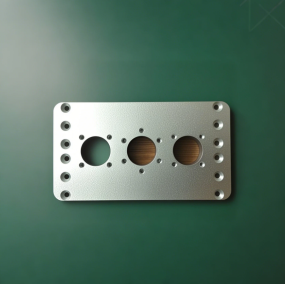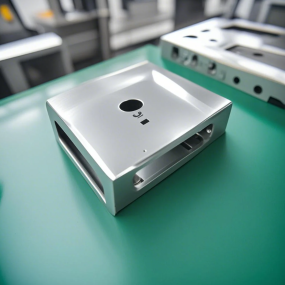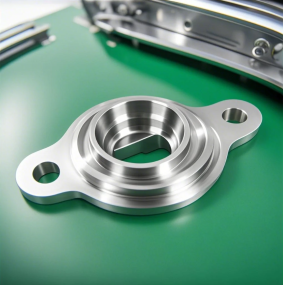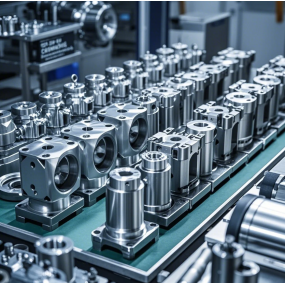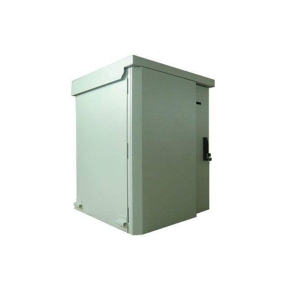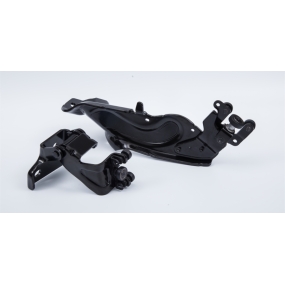Titanium alloy parts processing is a more complex process with high technical requirements. Then, the following small series will explain to you about the following types of wear and tear that should be avoided during the processing of titanium alloy parts: 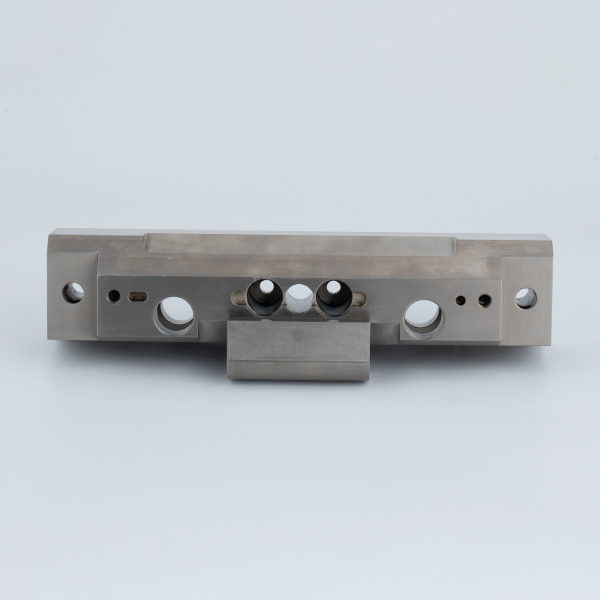 Tool wear Mechanical wear: Titanium alloy has high hardness. During processing, the relative movement between the tool and the surface of the workpiece is prone to mechanical friction, resulting in gradual wear of the cutting edge of the tool. This wear will reduce the cutting performance of the tool, affecting the machining accuracy and surface quality. In order to reduce mechanical wear, suitable tool materials can be selected, such as carbide tools, which have high hardness and wear resistance and can effectively resist the wear of titanium alloys. At the same time, a reasonable choice of the geometric parameters of the tool, such as increasing the front and back corners of the tool, reducing the contact area between the tool and the workpiece, can also reduce mechanical wear. Bonding wear: Titanium alloys have strong chemical activity during machining, which is easy to bond with the tool material. During the cutting process, the material on the surface of the tool will be "glued away" by the titanium alloy, resulting in the bonding wear of the tool. In order to avoid bonding wear, the tool can be coated, such as TiN, TiC and other coatings, which can form an isolation layer between the tool and the titanium alloy, reducing the direct contact between the two and reducing the possibility of bonding. In addition, the use of suitable cutting fluid can also play a good lubrication role and reduce the possibility of bonding. Diffusion wear: Under high temperature cutting conditions, titanium alloy and the atoms in the tool material will diffuse, resulting in changes in the composition and performance of the tool material, thus aggravating tool wear. In order to inhibit diffusion wear, the cutting parameters should be reasonably controlled to avoid excessive cutting temperature. For example, appropriately reduce the cutting speed and feed to reduce the generation of cutting heat. At the same time, choosing a tool material with good thermal stability can also improve the tool‘s ability to resist diffusion wear. Workpiece wear and clamping wear: During the clamping process of titanium alloy parts, if the clamping force is too large, it will cause local deformation or even scratches on the surface of the workpiece, affecting the dimensional accuracy and surface quality of the parts. In order to prevent clamping wear, a reasonable clamping method and clamping tool should be used, such as using a soft fixture or a soft material between the fixture and the workpiece to increase the contact area and disperse the clamping force. At the same time, precisely control the size of the clamping force to avoid damage to the workpiece due to excessive clamping force. Wear caused by cutting heat: Titanium alloy has poor thermal conductivity, and the cutting heat generated during processing is not easy to dissipate. It is easy to increase the surface temperature of the workpiece, resulting in changes in material properties, resulting in thermal deformation and thermal damage, which in turn affects the accuracy and surface quality of the workpiece. In order to reduce the wear caused by cutting heat, effective cooling measures can be adopted, such as the use of high-pressure cooling cutting fluid, which is directly sprayed into the cutting area to take away a large amount of heat. In addition, optimizing the cutting parameters and reducing the generation of cutting heat are also important measures to prevent the workpiece from being worn due to heat. Vibration wear: During the machining of titanium alloy parts, the vibration of the workpiece may be caused due to the action of cutting force or the vibration of the machine tool system. This vibration will change the relative position between the tool and the workpiece, resulting in uneven cutting, resulting in vibration wear, affecting the surface roughness and dimensional accuracy of the workpiece. In order to avoid vibration wear, it is necessary to improve the rigidity and stability of the machine tool, adjust the cutting parameters, and make the cutting process more stable. At the same time, the use of appropriate tool paths and cutting strategies can also reduce the generation of vibration.
Tool wear Mechanical wear: Titanium alloy has high hardness. During processing, the relative movement between the tool and the surface of the workpiece is prone to mechanical friction, resulting in gradual wear of the cutting edge of the tool. This wear will reduce the cutting performance of the tool, affecting the machining accuracy and surface quality. In order to reduce mechanical wear, suitable tool materials can be selected, such as carbide tools, which have high hardness and wear resistance and can effectively resist the wear of titanium alloys. At the same time, a reasonable choice of the geometric parameters of the tool, such as increasing the front and back corners of the tool, reducing the contact area between the tool and the workpiece, can also reduce mechanical wear. Bonding wear: Titanium alloys have strong chemical activity during machining, which is easy to bond with the tool material. During the cutting process, the material on the surface of the tool will be "glued away" by the titanium alloy, resulting in the bonding wear of the tool. In order to avoid bonding wear, the tool can be coated, such as TiN, TiC and other coatings, which can form an isolation layer between the tool and the titanium alloy, reducing the direct contact between the two and reducing the possibility of bonding. In addition, the use of suitable cutting fluid can also play a good lubrication role and reduce the possibility of bonding. Diffusion wear: Under high temperature cutting conditions, titanium alloy and the atoms in the tool material will diffuse, resulting in changes in the composition and performance of the tool material, thus aggravating tool wear. In order to inhibit diffusion wear, the cutting parameters should be reasonably controlled to avoid excessive cutting temperature. For example, appropriately reduce the cutting speed and feed to reduce the generation of cutting heat. At the same time, choosing a tool material with good thermal stability can also improve the tool‘s ability to resist diffusion wear. Workpiece wear and clamping wear: During the clamping process of titanium alloy parts, if the clamping force is too large, it will cause local deformation or even scratches on the surface of the workpiece, affecting the dimensional accuracy and surface quality of the parts. In order to prevent clamping wear, a reasonable clamping method and clamping tool should be used, such as using a soft fixture or a soft material between the fixture and the workpiece to increase the contact area and disperse the clamping force. At the same time, precisely control the size of the clamping force to avoid damage to the workpiece due to excessive clamping force. Wear caused by cutting heat: Titanium alloy has poor thermal conductivity, and the cutting heat generated during processing is not easy to dissipate. It is easy to increase the surface temperature of the workpiece, resulting in changes in material properties, resulting in thermal deformation and thermal damage, which in turn affects the accuracy and surface quality of the workpiece. In order to reduce the wear caused by cutting heat, effective cooling measures can be adopted, such as the use of high-pressure cooling cutting fluid, which is directly sprayed into the cutting area to take away a large amount of heat. In addition, optimizing the cutting parameters and reducing the generation of cutting heat are also important measures to prevent the workpiece from being worn due to heat. Vibration wear: During the machining of titanium alloy parts, the vibration of the workpiece may be caused due to the action of cutting force or the vibration of the machine tool system. This vibration will change the relative position between the tool and the workpiece, resulting in uneven cutting, resulting in vibration wear, affecting the surface roughness and dimensional accuracy of the workpiece. In order to avoid vibration wear, it is necessary to improve the rigidity and stability of the machine tool, adjust the cutting parameters, and make the cutting process more stable. At the same time, the use of appropriate tool paths and cutting strategies can also reduce the generation of vibration.
Hello! Welcome to EMAR's website!
 English
English » »
» »
 Spanish
Spanish Arabic
Arabic French
French Portuguese
Portuguese Belarusian
Belarusian Japanese
Japanese Russian
Russian Malay
Malay Icelandic
Icelandic Bulgarian
Bulgarian Azerbaijani
Azerbaijani Estonian
Estonian Irish
Irish Polish
Polish Persian
Persian Boolean
Boolean Danish
Danish German
German Filipino
Filipino Finnish
Finnish Korean
Korean Dutch
Dutch Galician
Galician Catalan
Catalan Czech
Czech Croatian
Croatian Latin
Latin Latvian
Latvian Romanian
Romanian Maltese
Maltese Macedonian
Macedonian Norwegian
Norwegian Swedish
Swedish Serbian
Serbian Slovak
Slovak Slovenian
Slovenian Swahili
Swahili Thai
Thai Turkish
Turkish Welsh
Welsh Urdu
Urdu Ukrainian
Ukrainian Greek
Greek Hungarian
Hungarian Italian
Italian Yiddish
Yiddish Indonesian
Indonesian Vietnamese
Vietnamese Haitian Creole
Haitian Creole Spanish Basque
Spanish Basque


